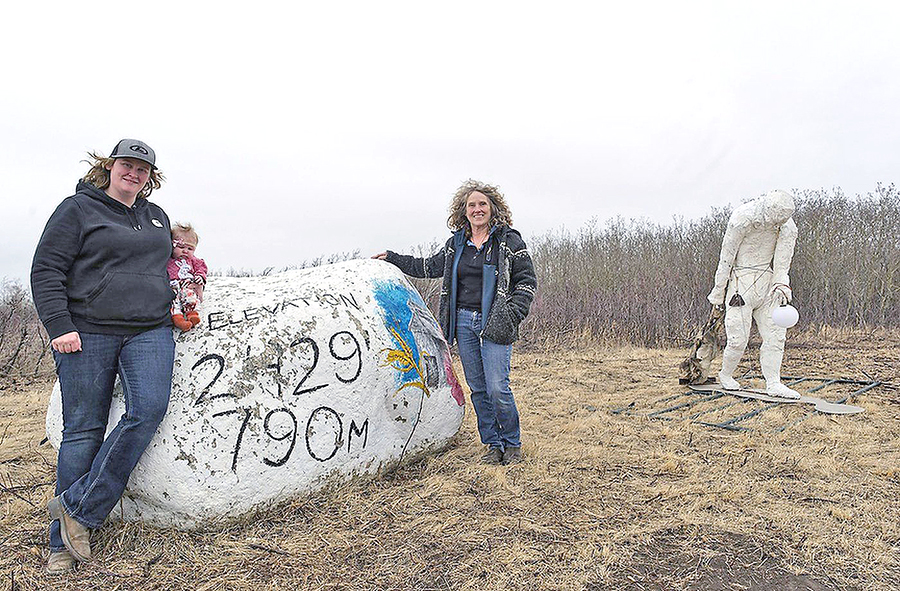Daysland residents hear hard truths about aging infrastructure during public meeting

Daysland residents heard a number of important topics presented during an Open House hosted by Council and held on Thursday, Oct. 27 at the Community Hall.
Many of the recommendations made in the inspection were centered towards Council working more efficiently, using planning tools like Strategic Planning, quarterly reviews of Council accomplishments, progress reports from administration, governance self-assessment, and took residents through the many steps that Council has adopted to satisfy these recommendations.
He also talked about Council adopting a new Code of Conduct, that includes confidentiality, and supplemental training for Council members, including orientation and procedural training, which have also been met.
Krips talked about a recent petition to Council, made in August, regarding a proposed borrowing bylaw for a curbs and gutters project on the north end of 50th Street, advising residents that the new lots sold with “the distinct impression that they were fully serviced lots, with curbs and gutters promised back in 2012.”
Krips said that he dealt with the petition, that was deemed invalid, and met with residents who were key in organizing the petition. “I believe it was a positive meeting.”
He promised that Council is looking at their concerns, and added, “There are items we know that require resolution, and if you have more, I invite you to bring them forward.”
Krips said one of the concerns was the truck route on Reist Drive, and trucks using the golf course road to access the new grain facility, saying that the town is working to look at solutions, including a 50 per cent permanent road ban, meeting with Flagstaff County and Flagstaff Waste Management to address these issues.
He brought up a number of issues Council is working on, including sidewalk replacement, vacant buildings, playground upgrades, back alley maintenance, the Arena/Community Hall parking lot, an underground infrastructure assessment, Main Street beautification, and new street lights-changing to LED next year.
He also noted that Range Road 164, to Paterson Grain, has been rebuilt by Flagstaff County to a very high standard, which included culvert replacements, including a known problem spot near Providence Place. “Our thanks to the County, and their staff, for working with us.”
Krips then introduced Dave McReynolds, who is a Financial Advisor from CSP Municipal Solutions, to present the town’s Financial Overview 2016.
“I can honestly say the town staff is dedicated and hard working, and they do a great job. I am very, very impressed with them. What’s gone on here is to be commended. I’m very, very impressed.”
McReynolds provided residents with examples of the financial information that Council receives on a monthly and annual basis, saying it is imperative to have up to date financial accounts to accomplish long term planning and make good decisions for the future.
“Your town staff does a very good job of putting this information together in a timely basis for Council.”
McReynolds told residents that the town derives 92 per cent of its funding from property taxes and utilities fees, with the other eight per cent coming from grant funding.
He provided the breakdown of tax income, with 62 per cent from residential, and 15 per cent non-residential, noting that both the education and Seniors Housing proponents of residential taxes are purely flow-through, with the town required to forward these funds to the province and Flagstaff Regional Housing.
McReynolds broke down utility sales, with 40 per cent from gas sales, and 29.2 from water.
He also reviewed the town’s 2016 federal and provincial operating and capital grant funding and outstanding debentures.
He reviewed the 2016 capital budget, and some major purchases, like a new grader, and mower, and noted that the 50th Street project was currently on hold.
McReynolds noted that the town’s sewer system is reaching 60 years old, “It’s reaching critical mass.”
He estimated a replacement project value of around $2.8 Million, with the town needing to debenture $700,000 dependent on a successful grant application for the remainder.
“This town should be focused on sanitary sewer replacement, and all behind that, 100 per cent.
Then there are other projects like storm water movement, fire hydrants, water mains, sanitary sewer lateral connections, roadway resurfacing, sidewalk replacement, and Main Street beautification.
“Everyone wants to make Main Street beautiful, I get it. But we need to focus on what’s underground first, then the surface second.”
Residents also heard from Director of Maintenance and Infrastructure for the Town, Cody Mayne.
In his report, he talked about how he came to be in Daysland, starting in the town full time in public works in 2012.
Mayne said this year he had the opportunity to speak at the Alberta Water Conference of water operators about a unique issue, and solution, he encountered in Daysland. “I am truly proud to be representing the Town of Daysland.”
Mayne gave residents a summary of the equipment currently owned by the town, including a new (to the town) 2011 Cat 140M road grader. “We’re very proud, and very excited to use this during the coming winter.”
He talked about the new water treatment plant, saying, “We are very lucky, this is an excellent facility, and we are very proud of it.”
He then reviewed the town’s waste water systems and lagoon, saying, “It’s insufficient.”
Read the full story on Page 2 & 22 in the latest edition of The Community Press – still available on newsstands and online via E-Subscription!
Leslie Cholowsky
Editor








